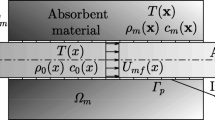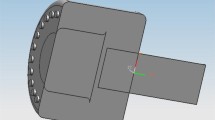Abstract
This paper describes the authors’ distributed parameter approach for derivation of closed-form expressions for the four-pole parameters of the perforated three-duct muffler components. In this method, three simultaneous second-order partial differential equations are first reduced to a set of six first-order ordinary differential equations. These equations are then uncoupled by means of a modal matrix. The resulting 6 × 6 matrix is reduced to the 2 × 2 transfer matrix using the relevant boundary conditions. This is combined with transfer matrices of other elements (upstream and downstream of this perforated element) to predict muffler performance like noise reduction, which is also measured. The correlation between experimental and theoretical values of noise reduction is shown to be satisfactory.
Similar content being viewed by others
Abbreviations
- A 1,A 0 :
-
internal areas of inlet and exit pipes, respectively
- c 0 :
-
velocity of wave propagation
- d :
-
internal diameter of pipe
- f :
-
frequency
- i :
-
iota, √−1
- k :
-
wave number, (θ/c 0)
- l :
-
length of pipe
- M :
-
Mach number, (W 0/c 0)
- M i :
-
inlet Mach number
- M 0 :
-
exit Mach number
- p 0 :
-
pressure of the undisturbed fluid
- p :
-
fluctuating pressure
- t :
-
time co-ordinate
- temp:
-
temperature
- u 1,2,u 2,3 :
-
radial fluctuating velocities at 1, 2 and 2, 3 interfaces of the control volume, respectively
- W 0 :
-
velocity of the undisturbed fluid
- w :
-
fluctuating velocity
- Y :
-
characteristic impedance,c 0/A
- z :
-
axial co-ordinate
- ρ 0 :
-
density of undisturbed fluid
- ρ :
-
fluctuation in density
- θ :
-
circular frequency
- ζ1, ζ2 :
-
acoustical impedances at 1, 2 and 2, 3 interfaces, respectively
References
Munjal M L 1975J. Sound Vib. 39: 105–119
Munjal M L 1986Acoustics of ducts and mufflers (New York: John Wiley) (in print)
Panicker V B, Munjal M L 1981aJ. Indian Inst. Sci. A63: 1–19
Panicker V B, Munjal M L 1981bJ. Indian Inst. Sci. A63: 21–38
Rao K N 1984Prediction and verification of the aero-acoustic performance of perforated element mufflers, Ph.D. thesis, Indian Institute of Science, Bangalore
Rao K N, Munjal M L 1984 A generalized decoupling method for analysing perforated element mufflers, Proceedings of the Nelson Acoustics Conference, Madison, USA
Sullivan J W 1979aJ. Acoust. Soc. Am. 66: 772–778
Sullivan J W 1979bJ. Acoust. Soc. Am. 66: 779–788
Sullivan J W, Crocker M J 1978J. Acoust. Soc. Am. 64: 207–215
Thawani P T, Jayaraman K 1983J. Acoust. Soc. Am. 73: 1387–1389
Author information
Authors and Affiliations
Rights and permissions
About this article
Cite this article
Narayana Rao, K., Munjal, M.L. Noise reduction with perforated three-duct muffler components. Sadhana 9, 255–269 (1986). https://doi.org/10.1007/BF02811968
Received:
Revised:
Issue Date:
DOI: https://doi.org/10.1007/BF02811968




